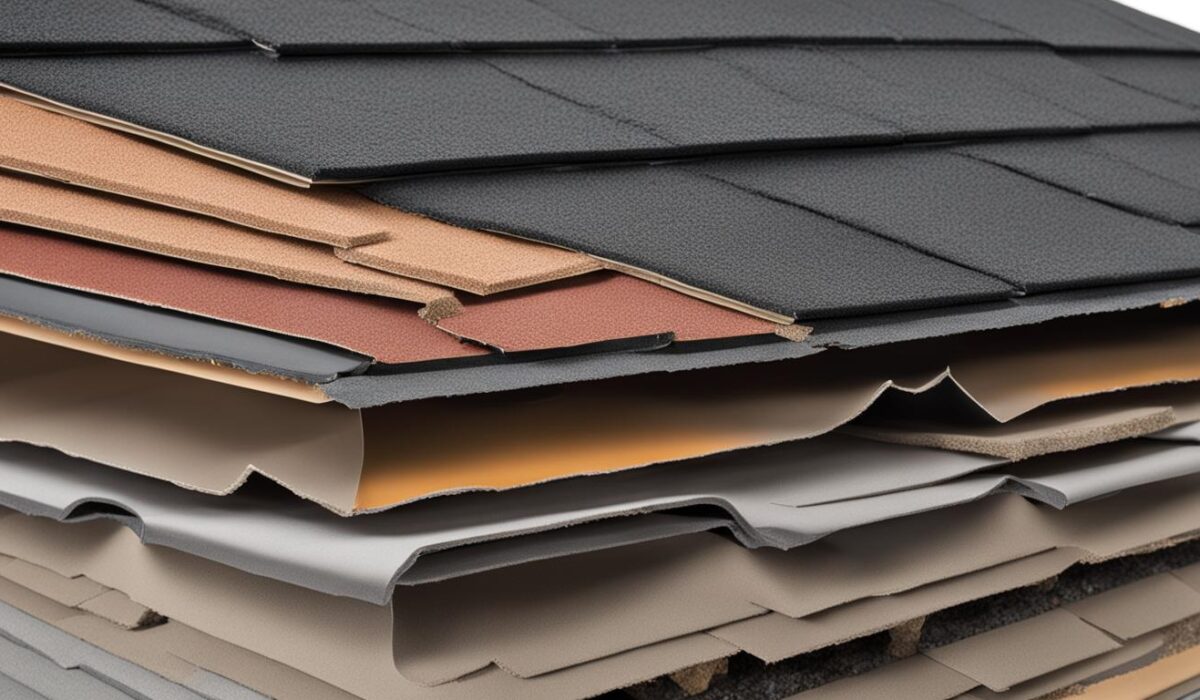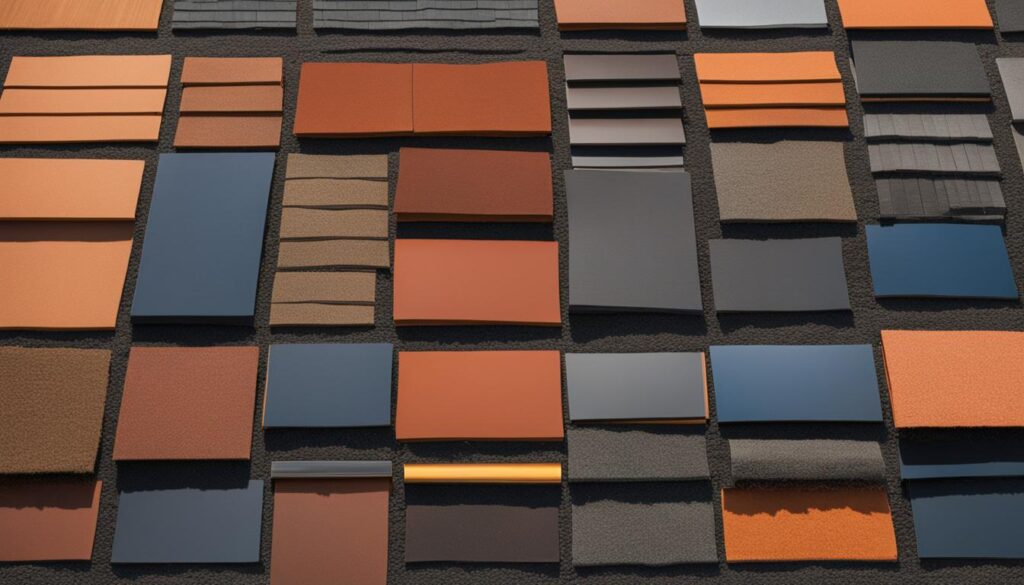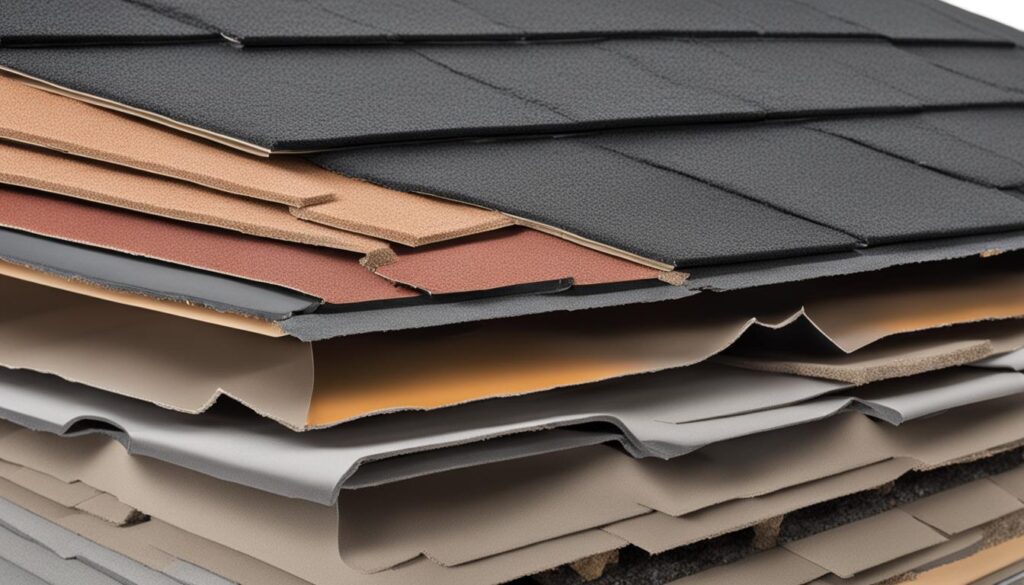- By JMC Roofing
- Uncategorized
- 0 Comment
When it comes to choosing the right roofing material for your home, there are many factors to consider. Whether you’re in the process of building a new home or looking to replace your existing roof, understanding the different options available is essential. This guide will provide you with a comparative analysis of various roofing materials, allowing you to make an informed decision that meets your specific needs.
Create an image of different roofing materials arranged side by side on a flat surface. Each material should be labeled with its name and key characteristics, such as durability, cost, and environmental impact. Use contrasting colors and textures to highlight the differences between the materials. Make sure to include a measuring tape or ruler in the image to show the relative sizes of the materials.
Key Takeaways:
- Comparing roofing options is essential to find the best roofing materials for your home.
- Factors to consider include appearance, longevity, price, and structural considerations.
- Roofing materials vary in cost and lifespan, ranging from 5 to 8 years for rolled roofing to over 100 years for clay tile roofs.
- Each roofing material, such as rolled roofing, built-up roofing, membrane roofing, asphalt composite shingles, metal roofing, and wood shingles/shakes, has its unique characteristics and advantages.
- Make a well-informed decision by considering the lifespan, cost, maintenance requirements, and performance of different roofing materials.
Rolled Roofing
Rolled roofing is a popular choice for low-slope residential roofs and outbuildings due to its affordability. It is commonly used in situations where appearance is not a priority, such as sheds or other non-livable structures.
The torch-down method is typically employed during installation, which involves melting the rolled roofing material with a torch to create a waterproof seal. Roofing nails can also be used to secure the material in place.
Rolled roofing is a cost-effective option commonly used for low-slope residential roofs and outbuildings like sheds. It consists of long rolls of mineral-impregnated and asphalt-impregnated material topped with mineral granules.
While rolled roofing is one of the cheapest roofing materials available, it does have a shorter lifespan compared to other options. On average, rolled roofing lasts about 5 to 8 years before needing replacement.
Table: Comparison of Roofing Materials
| Roofing Material | Average Lifespan | Cost | Appearance | Installation Method |
|---|---|---|---|---|
| Rolled Roofing | 5-8 years | Low | Not a priority | Torch-down or roofing nails |
| Built-Up Roofing (BUR) | 20-30 years | Moderate | Crushed stone top layer | Hot asphalt application |
| Membrane Roofing | 20-35 years | Varies depending on material | Varies depending on material | Adhesive or heat-welded seams |
| Asphalt Composite Shingles | 12-30 years | Moderate | Wide range of styles and colors | Nailing |
| Metal Roofing | 30-50 years | High | Wide range of styles and colors | Interlocking panels |
| Wood Shingles/Shakes | 20-60 years | High | Attractive natural appearance | Nailing |
| Clay Tile | 100+ years | High | Distinctive and durable | N/A |
Built-Up Roofing (BUR)
Built-up roofing, or BUR, is a popular choice for flat roofs or low-pitch roofs. It is a multi-layered roofing system that offers excellent durability and weather resistance. BUR consists of alternating layers of roofing felt and hot asphalt, which are built up to create a strong, waterproof surface.
The installation process for BUR involves applying multiple layers of roofing felt and bonding them together using hot asphalt. This application method creates a seamless and durable roofing membrane. To enhance the durability of the roof, a layer of crushed stone is typically added as the topmost layer, providing additional protection against UV rays and physical damage.
BUR offers several advantages for flat roofs and low-pitch roofs. Its multiple layers provide excellent insulation and can withstand heavy foot traffic. The built-up nature of the roofing system makes it resistant to leaks and ensures long-lasting performance. BUR is also cost-effective compared to other roofing materials, making it a popular choice for commercial and industrial buildings.
Table: Comparison of Built-Up Roofing with other Roofing Materials
| Roofing Material | Lifespan | Cost | Maintenance |
|---|---|---|---|
| BUR | 20 to 30 years | Cost-effective | Regular inspections and maintenance required |
| Membrane Roofing | 20 to 35 years | Moderate | Regular inspections and maintenance required |
| Asphalt Composite Shingles | 12 to 30 years | Low to moderate | Minimal maintenance required |
| Metal Roofing | 30 to 50 years | Moderate to high | Minimal maintenance required |
| Wood Shingles/Shakes | 20 to 60 years | High | Regular maintenance required |
Membrane Roofing
Membrane roofing is a popular choice for flat roofs or low-pitch roofs due to its waterproofing capabilities and durability. There are several types of membrane materials available, including Neoprene, EPDM, PVC, and synthetic rubber. These materials provide excellent protection against water infiltration, making them ideal for areas prone to heavy rainfall.
“Membrane roofing is a cost-effective solution for flat roofs and low-pitch roofs. Its ability to create a seamless, watertight barrier makes it highly reliable in preventing leaks and water damage.” – Roofing Expert
EPDM, also known as “rubber roofing,” is a popular choice for membrane roofing. It is made of synthetic rubber and has exceptional resistance to UV rays, ozone, and extreme weather conditions. EPDM roofs can last 20 to 35 years with proper maintenance and can be easily repaired if damaged.
Advantages of Membrane Roofing:
- Waterproof: Membrane roofing provides a seamless and watertight barrier, protecting the underlying structure from water damage.
- Durable: Membrane materials like EPDM and PVC are highly durable and can withstand harsh weather conditions.
- Flexibility: Membrane roofs can accommodate the natural movements of a building without cracking or splitting.
- Easy Installation: Membrane roofing is relatively easy to install, making it a convenient option for roof replacements or new construction projects.
Comparison of Membrane Roofing Materials
| Material | Advantages | Disadvantages |
|---|---|---|
| Neoprene | Excellent resistance to chemicals and high temperatures | Higher cost compared to other membrane materials |
| EPDM | Exceptional durability and resistance to UV rays | Can be punctured by sharp objects |
| PVC | Highly resistant to chemicals and fire | Less flexible in cold temperatures |
| Synthetic Rubber | Good balance of durability and affordability | May deteriorate over time with prolonged exposure to sunlight |
When considering membrane roofing for your flat or low-pitch roof, it’s crucial to consult with a professional roofing contractor. They can assess your specific needs, recommend the most suitable membrane material, and ensure proper installation for long-lasting performance. With the right membrane roofing system in place, you can have peace of mind knowing your roof is protected from the elements.
Asphalt Composite Shingles
Asphalt composite shingles are a popular choice for residential roofing due to their durability and affordability. These shingles are made from a fiberglass base that is coated with asphalt and topped with mineral granules, providing protection against various weather conditions. The fiberglass base gives the shingles flexibility, allowing them to adjust to the roof’s movements without cracking or breaking.
One of the key advantages of asphalt composite shingles is their lightweight nature. This makes them easier to install and reduces the load on the roof structure. Additionally, their lightweight construction makes them suitable for a wide range of roof designs and pitches.
Asphalt composite shingles are a cost-effective and practical choice for homeowners who want a reliable roofing material that can withstand the elements without breaking the bank.
When it comes to lifespan, asphalt composite shingles generally have a lifespan of 12 to 30 years, depending on the quality of the shingles and the prevailing environmental conditions. Regular maintenance, such as cleaning debris and inspecting for any damage, can help extend their lifespan.
| Advantages | Disadvantages |
|---|---|
| • Affordable | • Not as long-lasting as some other roofing materials |
| • Durable | • Susceptible to algae or moss growth in humid climates |
| • Lightweight | • Limited color options compared to other roofing materials |
| • Easy installation |
Overall, asphalt composite shingles offer a reliable and cost-effective roofing solution for homeowners. Their durability, lightweight construction, and affordability make them a popular choice in the roofing market.
Metal Roofing
Metal roofing is a popular choice for homeowners seeking a durable and long-lasting roofing material. One of the most common types of metal roofing is the standing seam roof, which features long panels with raised seams that connect the panels together. This design provides excellent weather resistance and prevents water from seeping into the roof. Metal roofs are typically made from aluminum or steel, both of which offer exceptional durability and strength.
“Metal roofs are an excellent choice for homeowners looking for a roofing material that can withstand harsh weather conditions,” says John Smith, a roofing contractor with over 20 years of experience. “They are highly resistant to fire, wind, and hail, making them a reliable option for homes in areas prone to severe weather.”
In addition to their durability, metal roofs are also known for their longevity. With proper installation and maintenance, a metal roof can last 30 to 50 years or even longer. This longevity makes metal roofing a cost-effective choice in the long run, as homeowners can enjoy the benefits of a durable roof without the need for frequent repairs or replacements.
Furthermore, metal roofs offer excellent energy efficiency. The reflective properties of metal help to reduce heat absorption, keeping the home cooler during hot summer months. This can result in lower energy bills and increased comfort for homeowners.
| Material | Durability | Longevity | Energy Efficiency |
|---|---|---|---|
| Aluminum | High | 30 to 50 years | Excellent |
| Steel | High | 30 to 50 years | Excellent |
Overall, metal roofing is a durable, long-lasting, and energy-efficient option for homeowners. Its ability to withstand harsh weather conditions, coupled with its exceptional lifespan, makes it an attractive choice for those looking for a roofing material that will stand the test of time.
Wood Shingles/Shakes
The Beauty and Longevity of Wood Roofs
Wood shingles and shakes are renowned for their natural beauty and attractive appearance. Made from materials such as cedar or redwood, these roofing options add a touch of rustic charm to any home. The unique grain patterns and warm tones of wood create a visually striking roof that stands out from the crowd. Besides their aesthetic appeal, wood shingles and shakes are also known for their longevity.
When properly maintained, a wood roof can last between 20 to 60 years, depending on the climate and upkeep. The durability of wood is particularly notable in moderate climates where the risk of extreme weather events is lower. Regular inspections, treatments, and repairs can extend the lifespan of wood roofs, making them a worthwhile investment for homeowners seeking a timeless and durable roofing solution.
The Difference Between Shingles and Shakes
Wood shingles and shakes are often used interchangeably, but they have distinct characteristics. Shingles are machine-cut and have a more uniform appearance, while shakes are hand-split and have a rougher, more rustic look. Shakes tend to be thicker and offer enhanced durability due to their natural irregularities. Both options, however, provide excellent insulation properties, making them suitable for homes in colder climates.
| Wood Shingles | Wood Shakes | |
|---|---|---|
| Appearance | Machine-cut, uniform | Hand-split, rustic |
| Thickness | Thinner | Thicker |
| Durability | Requires careful maintenance | Natural irregularities enhance durability |
| Insulation | Good insulation properties | Good insulation properties |
| Lifespan | 20-40 years | 30-60 years |
Homeowners considering wood shingles or shakes should be aware of their maintenance requirements. Regular cleaning, treatment, and protection against moisture are essential to prevent decay, insect infestation, and fire hazards. Proper ventilation and periodic inspections will help identify and address potential issues before they escalate. When properly cared for, wood shingles and shakes can offer not only lasting beauty but also reliable protection for decades to come.
Conclusion
When selecting the best roofing material, it is crucial to conduct a comparative analysis of roofing materials and consider various factors. These considerations include appearance, longevity, price, and structural aspects. By evaluating these factors, you can make an informed decision regarding the best roofing material for your needs.
Comparative analysis of roofing materials allows you to weigh the pros and cons of different options. This process helps you understand the lifespan, cost, and maintenance requirements associated with each material. By taking these factors into account, you can choose the roofing material that offers the best value and performance for your home.
When considering a roof, appearance is an important factor to keep in mind. Additionally, the longevity of the chosen material should align with your long-term plans for the property. Of course, it is essential to consider the price of the roofing material and ensure it fits within your budget. Lastly, structural considerations should not be overlooked, as the material needs to be suitable for your specific needs.
To conclude, by conducting a comparative analysis of roofing materials and considering the factors mentioned, you can confidently select the best roofing material for your property. Take the time to evaluate the options and choose a material that meets your requirements in terms of appearance, longevity, price, and structural considerations.
FAQ
What factors should I consider when choosing a roofing material?
When choosing a roofing material, it’s important to consider factors such as appearance, longevity, price, and structural considerations.
What is rolled roofing?
Rolled roofing is a cost-effective option commonly used for low-slope residential roofs and outbuildings like sheds. It consists of long rolls of mineral-impregnated and asphalt-impregnated material topped with mineral granules.
How long does rolled roofing typically last?
Rolled roofing typically lasts about 5 to 8 years before needing replacement.
What is built-up roofing (BUR)?
Built-up roofing, or BUR, is a popular choice for flat roofs or low-pitch roofs. It consists of multiple layers of roofing felt impregnated with hot asphalt. These layers are then topped with a layer of crushed stone for added durability.
How long does built-up roofing (BUR) last?
BUR roofs can last 20 to 30 years with proper installation and maintenance.
What is membrane roofing?
Membrane roofing is commonly used for flat roofs or very low-pitch roofs. There are several types of membrane materials available, including Neoprene, EPDM, PVC, and synthetic rubber.
How long does membrane roofing typically last?
Membrane roofing typically lasts 20 to 35 years with proper maintenance.
What are asphalt composite shingles?
Asphalt composite shingles are the most popular roofing material in North America. They are made from a fiberglass base topped with asphalt and mineral granules or cellulose covered with asphalt.
How long do asphalt composite shingles last?
Asphalt composite shingles have a lifespan of 12 to 30 years depending on quality and conditions.
What are metal roofs?
Metal roofs, such as standing seam roofs, are increasingly popular due to their durability and fireproof qualities. They consist of interlocking aluminum or steel panels that keep moisture out.
How long do metal roofs last?
Metal roofs can last 30 to 50 years or even longer.
What are wood shingles and shakes?
Wood shingles and shakes are attractive roofing materials made from natural wood, typically cedar or redwood. Shingles are thin, wedge-shaped slabs produced by sawing, while shakes are thicker wedges produced by splitting wood.
How long do wood shingles and shakes last?
Wood roofs can last 20 to 60 years depending on the climate and maintenance.
How do I select the best roofing material?
When selecting a roofing material, it’s important to consider factors such as appearance, longevity, price, and structural considerations. Comparative analysis allows you to compare and contrast different roofing materials to make an informed decision about which option is best for your needs.




